Fishing Report: Oct. 15, 2021

Look out for triple tail near those stone crab traps
Triple tail action has been nonstop lately around the area and will only improve as stone crab season opened today. This means more traps will be around, which act as big chum blocks along the bays and beaches, says Captain Dylan Hubbard of Hubbard's Marina.
MADEIRA BEACH, Fla. - Every Friday morning, Captain Dylan Hubbard of Hubbard's Marina joins Good Day to fill viewers in on his fishing forecast as we head into the weekend.
Here is his fishing report for October 15, 2021.
Inshore
We continue to see patchy areas of these red tide blooms that come and go, grow and shrink in size every few days. Keep an eye on the forecasts and reports via this link if you are interested.
Triple tail action has been nonstop lately around the area and will only improve as stone crab season opened today. This means more traps will be around, which act as big chum blocks along the bays and beaches. Plus, they come with marker buoys to give the triple tail a spot to hide.
You must find a larger one to be able to keep them though as their latest size limit change brought the minimum size to 18 inches overall. You’re allowed two per person. At the new minimum size, that’s quite a bit of good eating fish if you can get two of keeper size.
They can be found along virtually any markers, buoys, or floating debris from upper Tampa Bay all the way to 1,000 feet of water offshore. This is the time of year you want to keep your eyes peeled while cruising between fishing spots and check those floating objects and markers.
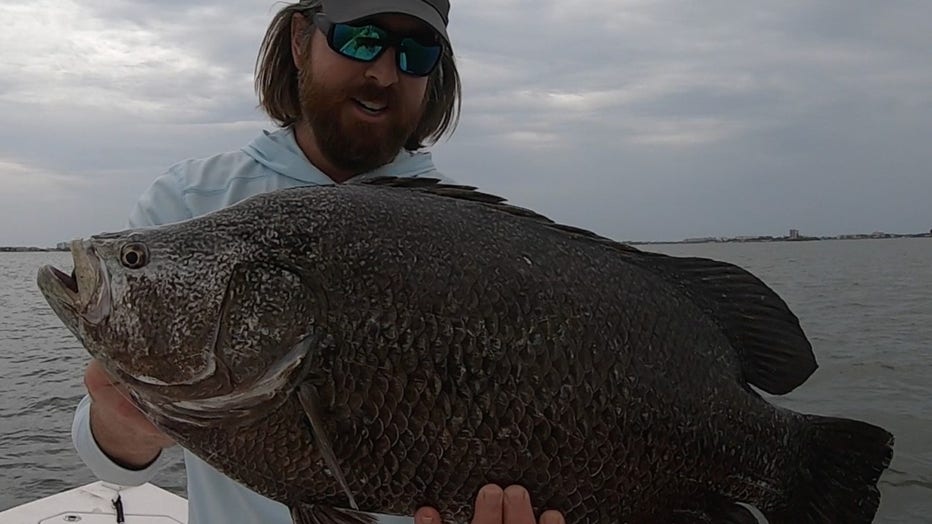
Tripletail caught inshore (Credit: Hubbard's Marina)
If you spot one, don’t try and slow down quickly next to the buoy. Keep going and slow down normally, then circle back only after preparing a rod and reel and bait to present to these easily spooked fish. Once, they get spooked they are gone. We often see them cruising out on our near shore fishing trips along the beaches and we can mark the spot and catch them hours later the return trip even from our large party boats when we use these stealthier methods of approach.
They love live shrimp or artificial lures made to mimic shrimp or even those soft plastic paddle tails. If you’re not the best at casting, you can even use a popping cork to give yourself more weight in your rig and overcast the buoy or marker or debris hiding the fish. Then, retrieve line while manipulating your rod tip to ensure that bait gets pulled back to the appropriate strike zone.
Redfish action is super-hot around Tampa Bay right now. There’s been big schools of fish up and down the sides of the bay with many fish near shore spawning too. We have landed quite a few redfish by mistake near shore as they head out and back from their spawning sites in the gulf. In the bay, we are finding most of these schools around the flats, oyster bars, and mangrove islands and shorelines. Look for schools of mullet or rays that are cruising these areas and often actively feeding redfish will follow. The best time remains to be in the morning or dusk, but even through the day you can find actively feeding redfish where water is moving, and bait is present.
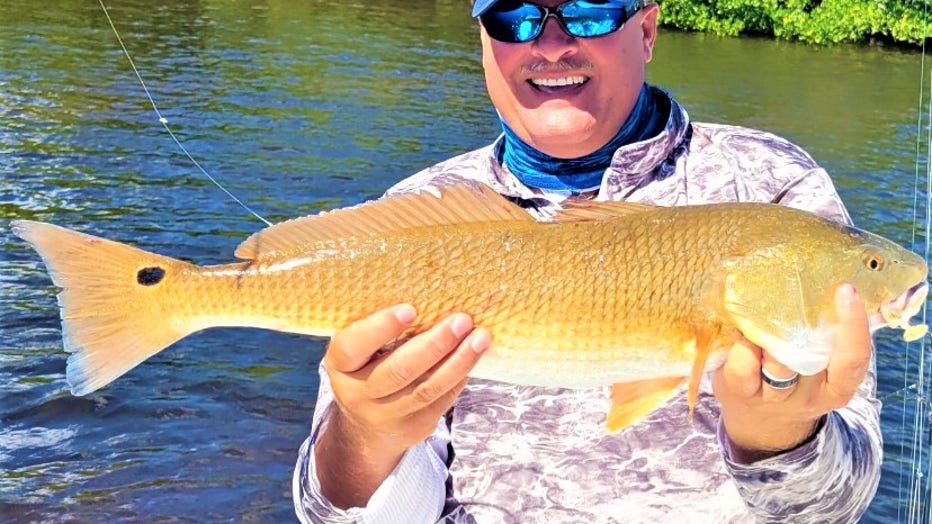
Redfish (Credit: Hubbard's Marina)
Snook action is really moving back into the bay, but there’s still some fish on the beaches too. Bigger fish are remaining in deeper areas around docks, bridges, and other structures. Like the redfish, best action is early morning and around dusk, but you can find feeding snook at the optimal tidal times around the flats, mangroves, and passes. Nighttime snook fishing around the dock lights and bridge lights remains hot where you can find clean water that isn’t dealing with the red tide blooms that still plague our area.

Snook (Credit: Hubbard's Marina)
Trout action is steady through the area with a lot of the bigger trout are tougher to find lately but, overall, the action is going well. We are seeing them most still on those deeper holes, cuts and drop offs adjacent to flats, structures and mangroves where they can easily ambush passing baits. Look for the trout using live shrimp, white bait or slower moving soft plastics or jerk baits.
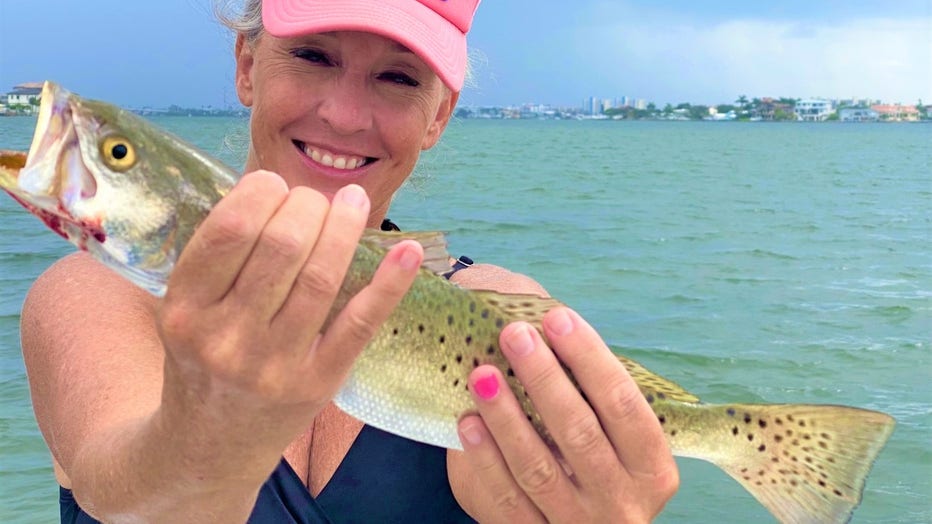
Trout (Credit: Hubbard's Marina)
Mackerel action is very solid in the bay, in some passes and along certain beaches when the red tide isn’t prolific. The bay though remains clear and has really ‘trapped’ a lot of mackerel inside the bay with red tide blooms looming around the mouth of the bay it seems we are having a lot of mackerel just cruising the bay attacking schools of baitfish around local bridges, piers, jetties and breakwaters. Look for them in deeper areas where bait is present or around structures where water is moving, and bait is hiding like bridges. Even some beach piers, like at Fort De Soto, are producing active mackerel action along with of course the skyway fishing piers.
Pompano action is heating up around local passes, bridges, and sandy areas adjacent to the flats. Look for these guys all over the area where you can find solid sandy cuts where they can forage for crustaceans on the bottom in clean clearer waters. Passes are always my favorite areas to drift for pompano using pompano jigs or live shrimp on the bottom, but local bridges with good sandy areas are all good areas even inside the bay to find these great eating fish.
Flounder action is picking up around the bay as well this time of year and you can find them in many of the same areas described above for pompano. We are seeing them too around the flats in areas they can camouflage into the sand and ambush passing bait moving around the flats or even around structures like docks and bridges or adjacent to rock piles too!
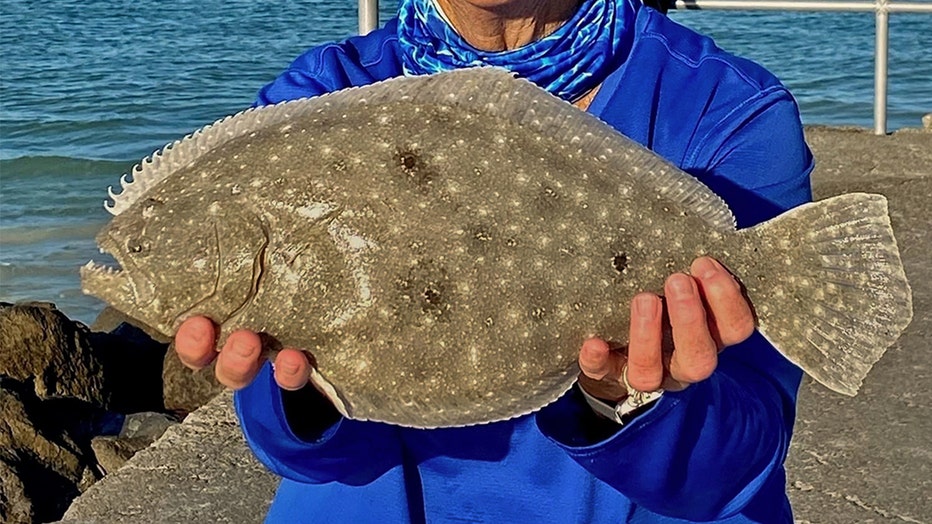
Flounder caught inshore. (Courtesy: Captain Dylan Hubbard)
However, keep in mind there is a seasonal closure on flounder starting today that protects them during their spawn. They will re-open to harvest December 1, once that spawning time frame dwindles.
Sheepshead fishing is picking up around the area as waters cool, we are seeing more and more of these guys around the local structure. Docks, bridges, piers, jetties, rock piles and all sorts of structures will become inundated with sheepshead as the local water ways continue to cool off. These guys love lighter tackle, minimum weights, small crabs or pieces of shrimp and you can even chum them up by scraping off barnacles from the structure you plan to fish at the start of a tide.
Mangrove snapper action is still going well around the area but will start to slow as the bigger fish will start moving out to the near shore waters. However, many of the smaller snapper hangout and don’t leave the bays and estuaries until they reach around 10-12 inches. We are seeing some monster mangroves -- upwards of 20 inches –around the edges of the shipping channel. Chumming areas on slack tides and fishing shrimp or small pinfish on ultra-light jig heads and around 20lb test is a great way to find these big mangrove snapper in the bay!
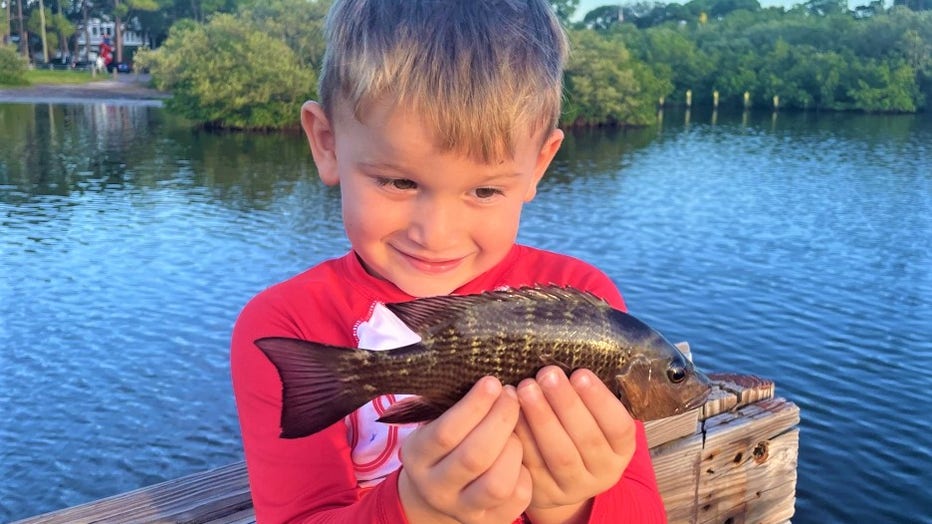
Mangrove snapper (Credit: Hubbard's Marina)
Black drum action still going well around the area with some truly monster drum coming up around local docks, piers, bridges and jetties. Occasionally, you can find them cruising the flats and bays too! They love cut crabs on the bottom or live shrimp and will even get fooled by slower moving soft plastics from time to time if you spot them cruising.
Jack crevalle action is going well too. These guys aren’t the best table fare, but they are tons of fun and the bite is often super fired up when they happen upon a school of bait or an area they can feed actively. We are seeing them from the beaches to the upper bay, around virtually any area that is holding bait.

Jack crevalle (Credit: Hubbard's Marina)
Near shore
Hogfish action has been slowly picking up, with some days producing more than others, but we are noticing a slow uptick. They are primarily caught on live shrimp, but they love a variety of crustaceans.
The best approaches are outlined in our video on our website. Under the ‘fishing trips’ tab, click ‘fishing video links’ then ‘fishing tips and tricks’ and then select that 15-minute video named ‘How to catch hogfish and what rig to use.’
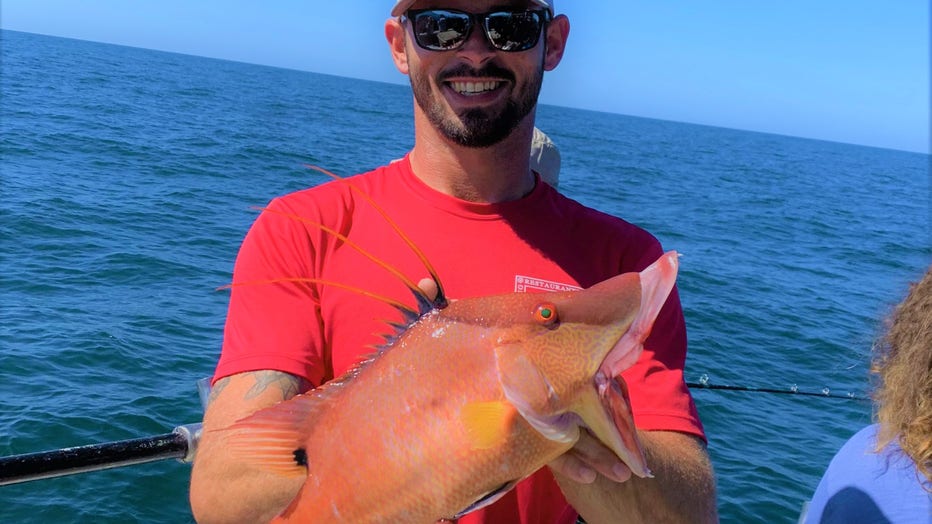
Hogfish (Credit: Hubbard's Marina)
We like around 30lb floro and about a 3-4ot hook with a spinning rod and reel with around 20lb braided line. We find them around as shallow as 30-40 feet of water and they bite well up to around 70-90 feet of water. However, we primarily target them around 40-50 feet of water. You can catch them deeper, but the deeper you go the more other aggressive fish are around to bite the shrimp you send down to target these hogfish.
Lane snapper action still very hot near shore but, unfortunately, they close end of the day on Oct. 17. However, the word is they will re-open before the end of the year.
Mangrove snapper are active near shore and you can catch quite a few using around 30-40lb leader and double snelled 3-4ot hooks and a smaller chunk of threadfin or the light jig head with a chunk of threadfin or shrimp. We are seeing them around virtually all hardbottom areas in the deeper near shore waters around 50-70 feet and beyond.
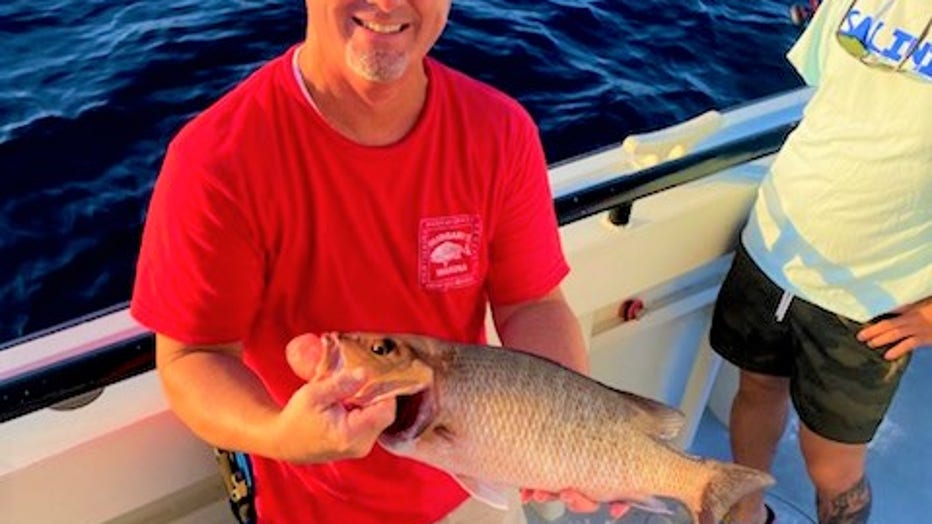
Mangrove snapper (Credit: Hubbard's Marina)
Scamp grouper fishing has been going very well for near shore waters especially around that 70-100 feet area. We are seeing a considerable number of these good eating scamp grouper even in our near shore waters. Good to see these guys seemingly getting more prolific as the gag grouper population dwindles.
Mackerel action is going extremely well near shore if you can find areas of cleaner waters. We have a lot of coastal red tide bloom going until you get out there up to around 40 feet of water We are seeing plentiful mackerel moving along artificial reefs, wrecks and big ledges holding bait. Plus, along with these areas are occasionally finding nice kingfish too. The kingfish action should only proliferate as the water temps continue to cool.
Offshore
Red snapper opens today for the federal-for-hire recreational fleet. We are going to be able to target and harvest red snapper until end of day on Nov. 5. So. for the next three weeks, you have the opportunity to get out there and catch some nice American red snapper.
These guys are thick offshore and we’re looking forward to filling up some fish boxes with fat red snapper out there past 120 feet of water using threadfin, cut bonita strips, and whole squid if we can’t get our live pinfish due to the red tide issues continuing.
Scamp grouper action is going very well out deeper offshore beyond around 140-160 feet of water where we will be fishing most of this short red snapper season extension, we should also see some fat scamp grouper too! These guys love smaller pinfish, cut threadfin or even sometimes strips of cut squid wing. Plus, vertical jigs like the 4-6oz hammered diamond jig bounced just on or just above the bottom.
Mangrove snapper action is going extremely well offshore right now with a very large average size of healthy mangrove snappers coming up. These guys are all caught using that double snell rig and cut threadfin or sardines on the bottom. I like using around 50-60lb leader this time of year when gag grouper are open and around. However, if the bite is slower and pickier, I will drop down to 40-50lb leader if needed to get these mangroves to chew.
Yellowtail snapper, vermillion snapper, big porgies, almaco jacks, and others are out there offshore too making it a great time to go target some good eating mangroves, scamp and for a few weeks the red snapper too.
Plus, we are seeing the blackfin tuna thick out in the offshore waters with the occasional kingfish and maybe wahoo around too! It’s a great time to remember that flat line and to troll between fishing spots while offshore beyond around 120 feet of water.
DON’T BE A FOOL, bring a venting tool & descending device
Keep in mind the importance of dead discards and discard mortality when engaged in near shore or offshore fishing. How many do you know right now that are all for catching and releasing snook, redfish, and trout but will be the first in line to kill a mangrove snapper, gag grouper, or red snapper? But the attitude completely changes when discussing these offshore species?
Plus, the same person inshore that will hold their breath and wet their hands before handling a breeder snook will go offshore and then cull through 20 red snapper before keeping their two red snapper they deem large enough to fill their two-fish bag limits. Meanwhile, the other 18 they released will often end up suffering fatal damage if not properly descended or vented?
Please help us to spread the word on the importance of descending or venting your released fish. Descending devices are most easy to use and quick to pick up on their use. They are most effective for most anglers.
However, an expert and precise angler with proper training and tons of experience can use a venting tool properly with similar outcomes. A venting tool requires you to pierce the fish while most descending devices are much less invasive. While using a venting tool, it is imperative you pierce them in the exact right spot, and you do not go but a quarter-inch or less in the fish. Most venting tools require you to ‘choke up’ on the tool to prevent over-penetration into major organs.
When fishing deep water, especially in the hot summer months, please make sure to treat all fish intended to be released like that breeder snook inshore and minimize the time it takes you to get him from the bottom to the boat using heavier proper tackle, not an ultra-light spinning reel.
Then once onboard, minimize the time out of the water. Then use a proper de-hooking tool and then, for the love of God, use a descending device or venting tool PROPERLY to ensure that fish has a chance to live another day.
Three things will help ensure the survivability of those fish released offshore:
- Making sure they are brought up quickly and do not expend all their energy in the fight.
- Make sure they are unhooked smoothly, easily, and as quickly as possible.
- Finally, make sure they spend the least amount of time at the surface at negative pressures where barotrauma exponentially increases its effect with each passing second.
Also, keep in mind when the water is warm, there is less dissolved oxygen content and the chances of barotrauma increase even more while its effects can be even more deadly.
LINK: Here’s all the information and more on barotrauma and how to mitigate that fatal damage to your future offshore catch
**Note: I recommend the Salt Strong articles at the bottom of the page under ‘webpages.’ I helped them develop those personally.
STATE SURVEY to improve recreational data and access
It is imperative that you have your Gulf Reef Fish survey endorsement on your fishing license.
You should get one if you are a private recreational angler or diver fishing from a private boat anywhere in Florida who intends to harvest, attempt to harvest or possess one or more of the following reef fish species: mutton snapper, yellowtail snapper, hogfish, red snapper, vermilion snapper, gag grouper, red grouper, black grouper, greater amberjack, lesser amberjack, banded rudderfish, almaco jack, gray triggerfish, Gag grouper, Red grouper, Scamp grouper, Mangrove snapper, Lane snapper, Kingfish, Tuna, or Mahi mahi.
Here is all the information and more on that program and how you can sign up.
TERMS OF REFERENCE:
INSHORE – from the back bays out to the bridges and including right on the beaches
NEAR SHORE – From the beaches out to 20 miles, or up to 100ft of water
OFFSHORE – from 20 miles or 100ft and beyond
For more fishing reports, photos, videos and more check out Hubbard’s Marina on Facebook, Instagram, YouTube, or Snapchat. Just simply search "HubbardsMarina" and do not forget our family motto, "If you’re too busy to go fishing, you’re just too busy!

